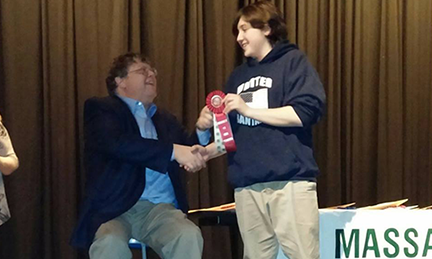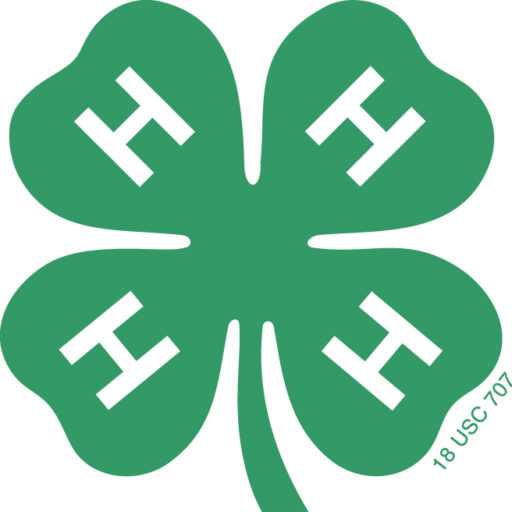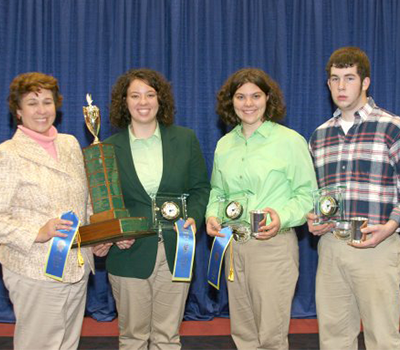James was growing older, and he was busy going to school, spending time with his friends and 4‑H club. When he had a difficult day at school, he could always go into the coop and hang with his “girls.” They trusted and depended on him every day, and they would always make him feel better. He always found time for them and was sure to see to all their needs.One cold morning, near the end of winter, James found Goldie in the coop flopping around and having a hard time walking. He brought her into the house to see what was wrong. She could barely stand up and was getting weaker as the day went by. She wouldn’t eat or drink. He decided to make a comfortable bed of hay for her in the basement to separate her from the others. Goldie continued to get weaker that night and into the next day. I let James stay home from school so he could care for her. He called his 4‑H leader, and she told him what he had feared – that Goldie wasn’t going to make it through the night.
“Sometimes chickens get sick and weak and will just lie down and go to sleep,” she explained. “You are doing everything you can by making her comfortable.”
She also offered to come and take Goldie so he wouldn’t have to watch her die. James was heartbroken. He would have to face his biggest fear – he was going to lose one of his beloved chickens, and soon. He worried that Goldie was in pain and didn’t like to see her so sick. James decided to keep her at home. Saying goodbye to Goldie was so difficult.
Throughout the day, he would go check on her, and each time he told her, “I love you, Goldie.”
Goldie continued to grow weaker, until she finally lied down, closed her eyes, tucked her head under her body and went to sleep. Shortly after, she stopped breathing. I was the first to find her. Goldie died! – I sadly realized. I wanted to be first just to make sure before James saw her.
We put her lifeless body in a box with some hay. James’ older brother dug a grave for her outside under the apple tree where other family pets were buried. We gathered at the grave to say goodbye and James’ dad said a few kind words on how much we all loved her, how happy she was, and how she brought James a lot of joy. Both of James’ brothers said, “Goldie was a good chicken.”
“Goldie was the friendliest chicken I ever had,” James remembered. “She was the first one to come over to me when I first got them.”
They all helped shovel dirt and placed rocks onto the grave, then walked away. James stood for a moment, reached down, and touched her grave, saying tearfully, “I feel like she is still here – that she is not gone.” He looked down one last time and said, “I love you, Goldie.”
The next day James got up, got dressed and went out to the coop. He knew the chickens were depending on him so he filled the water and feed, said good morning and let them out into their run. He wondered if they would notice that Goldie was gone. When he entered the coop, they squawked more than usual. James believed it was because they missed her.
He went off to school, but it wasn’t like any other day. He realized what it felt like to lose a beloved pet. Losing Goldie was so heartbreaking, but he acknowledged that even though he was sad, he would be OK. Life would go on without Goldie.
After Goldie died, I was so relieved that he had handled it so well. He had reached out for support from his 4‑H community, and he managed it just like he took to building the coop and caring for their daily needs. Although there are times when he still misses Goldie, he is more socially confident and sure about his goals because of the support he has received from his 4‑H community.

The whole process has been so empowering for him and gratifying for me to know that he can do this. I am thankful that he has friends and a community that gets him and where he feels he belongs. It took a few years for this to happen for him but he now has many ribbons and even performed at the State 4‑H Visual Presentation day placing second with this VP on Model Railroading.
During his first year keeping records, James has written about this journey in his 4‑H story. In his own words:
“This is probably one of the first times in my life where I’ve been accepted by everyone in the club, and of course, I accepted all of them. I definitely think that whenever I’m at 4‑H meetings or events or just hanging out with my best friends from 4‑H, I am happier than I’ve ever been and always have a smile on my face. That is why I love 4‑H.”
James has recognized that 4‑H has given him confidence and improved his self-esteem. Anytime he can talk about his interests he is happy and confident, and now he has found a venue to do this where he is accepted and respected.
James’ story is not unique as I know there are other kids out there who do benefit greatly from the 4‑H experience. It has opened many doors for us as a family that we would not otherwise have discovered. I also have been inspired by his determination, and I am authoring and illustrating a children’s story based on Goldie.
By the way, what’s his new interest? He’s learning to play the Banjo. Trains, Chickens and Banjos, Oh My! Is there a club for that?















